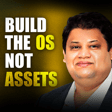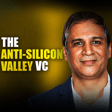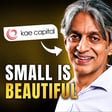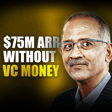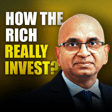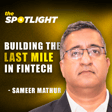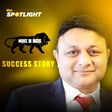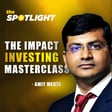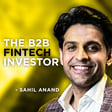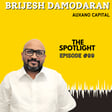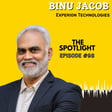Become a Creator today!Start creating today - Share your story with the world!
Start for free
00:00:00
00:00:01

Manufacturing TVs at scale in India | Sharan Maini @ Veira Group
Veira Group is an Original Device manufacturer - they design and manufacture televisions for other brands. Sharan Maini is from the second generation of the Veira Group promoters, taking forward his father’s legacy in manufacturing televisions. He talks about the journey of the group from making 10 radio sets a day to manufacturing thousands of televisions a day.
Transcript
Introduction to Veragru's Business
00:00:00
Speaker
Hi, I'm Sharan Mani. I'm one of the promoters at Veragru. The company is currently involved in the manufacturing and development of LED televisions, washing machines, air coolers, and a lot of audio products as well.
00:00:25
Speaker
While most of us assume that a lot of electronic appliances and gadgets we use on a daily basis are made in China, television is one category that actually has a robust supply chain in India. And in this episode, your host Akshay Dutt talks to one of the major television manufacturers in India. Vera Group is an original device manufacturer, which means that they design and manufacture televisions for other brands. The television in your living room may have a brand of a Korean and an American company, but it may actually be manufactured by Vera Group.
00:00:55
Speaker
Sharan Meni is from the second generation of the Vera Group promoters, taking forward his father's legacy in manufacturing televisions. He talks about the journey of the group from making 10 radio sets a day to today manufacturing thousands of televisions a day. Stay tuned and subscribe to The Founder Thesis Podcast to learn about how entrepreneurs are making in India and selling to the world.
Veragru's Expansion Journey
00:01:22
Speaker
My father, he started this way back. We used to make, he started with making audio cassette players at that time. But how did he start? Like how did he get the money to start? Well, I think, you know, at that time, money was a crisis for everyone. So I think he took some loans from multiple people, started very, very small with a very, you know, audio cassette players were made in a small room.
00:01:52
Speaker
and even making 10 pieces a day was a big deal at that time. So, yeah, it started that time and... So, that must have been like an assembly set up, like you would buy components, assemble themselves. Yes, yes, yes. It would be complete assemblies and the components, the dies, the metal parts usually were bought and
00:02:19
Speaker
As I said, making even 10 pieces was a big deal at that time. It started with making 2 pieces a day and 10 pieces became a big deal in the span of 2-3 months. From there, how did he scale it up? From that one rule where he was doing 10 pieces a day.
00:02:39
Speaker
I think things got much more scaled up once India opened up. As the demand increased, my father also set up a factory where audio could play. Who was he selling to?
00:02:56
Speaker
We had our own brand, it's called Iconic, that brand still exists. With that brand, the multiple distributor and dealer networks across India were taking the products, liking the products, and still there are a huge audience who still want that brand in the states of Maharashtra, Gujarat, where that confidence of the product still exists.
00:03:29
Speaker
By when did he earn enough or was he making enough Mahati revenue to invest in a factory? Where did that transition happen from?
Technological Adaptation and Strategy
00:03:38
Speaker
I think the factory was taken on rent to start with. At that time, there was a pugly system. We all know. So, it was taken on rent. That is majorly, the rent is very, very less. So, we took a factory in Karul Bagh at that time. Why is the rent less? What is this pugly system? I am not aware.
00:04:06
Speaker
I am also not very aware. I just know the rent is very less and it goes on for years. It's majorly with very little rent. Factory was taken and so we started making more from 2 to 10, from 10 to 20 reached up to 500. By 1990, when India opened up, the VCD and the DVD players had come in.
00:04:34
Speaker
The speaker segment didn't come in. The technology kept changing. My father used to like getting into new technologies. By the time it came 1994-1995, we were approximately making 2-3,000 DVD players a day.
00:04:55
Speaker
So yes, the consumer demand increased. The way of selling increased. We were making for multiple brands also at that time. And that is what the business has grown even today. That's what we are doing even today. Then we got into making CIT televisions. Which were the first brands that you got a deal with? That time it used to be a brand called Belltech.
00:05:18
Speaker
Yeah, also an Indian brand, there was a bell deck, there was a crown, and a few brands, few Indian brands who started. So yeah, it started with that. And then we started making televisions, the big televisions. Okay, from that same Karolbach factory earlier? No, no, no, of course. We changed our factories from Karolbach, we went to Narayana, we took another plant in Narayana,
00:05:47
Speaker
Then we moved to a factory in Noida and since then we've been adding our factories in Noida as a basic self. So started with a big television and I think CIT television was started by my brother and we became ODM's to hire and intake at that time and the television also. What is ODM word? What does that mean?
00:06:16
Speaker
It means own design manufacturers. We are a design manufacturer, that means that we design the product, we make the product and then we send the design of the entire product and we not only design the product, we also manufacture it and give it to separate brands.
00:06:35
Speaker
Okay. So a brat can outsource the manufacturing of that and they can just focus on marketing. So like higher will just focus on marketing and you are taking care of the actual product being available for selling. Yes. Yes. Yes. Okay. Okay. Got it. Okay. Okay. So yeah, you were telling me you got into TVs. Higher was also into CRT. Is it like
00:07:01
Speaker
Yeah, I think not only multiple brands, more than 10 to 12 brands were on CRTs. I think most of the brands doing LED TVs were on CRTs at one time. So we were a major manufacturer for CRTs. So I guess higher would be importing LED from China and CRT would be getting made in India or something like that.
00:07:23
Speaker
not sure about that, how they were doing LEDs. But majorly, as I said, multiple brands were buying CIT televisions from us and then that moved to LED TVs and the scale kept increasing, the Indian consumers' demands kept increasing.
00:07:43
Speaker
Indian manufacturing kept increasing with the support of the government and now that has scaled up to televisions, washing machines and cooler speakers. By the time you joined, what was the scale? What was the size of the factory or what was the number of daily manufacturing capacity and some of those things? Tell me about that.
00:08:09
Speaker
I think I joined in 2007. At that time, LED TVs had not come in. It was majorly CIT TVs, but CIT TVs were already at a big scale. We were doing approximately 2,000 to 3,000 CIT TVs a day, approximately 1,000 to 2,000 DVD players or audio players a day.
00:08:34
Speaker
But the major point is that CRT was more of an Indian product. It wasn't an international product. Internationally the world had moved to LED televisions even at that time. So the international products like televisions, like home theater systems, these came in much later by 2009-2010.
00:09:03
Speaker
So like, you know, tell me your own journey and we are a group, like when you started, what were you doing? And, you know, subsequently, what are the ways in which you contributed to its growth?
00:09:19
Speaker
I started at a time when there was a lot of transition and technology happening, especially in the visual zone. TVs were turning into a USB player, and that cable TV journey was finishing, Tata skies were coming in. USB was the new thing. So the way of watching anything was changing.
00:09:43
Speaker
So, it was very important to quickly adapt. Otherwise, you would rather the technology segment die very soon.
00:09:51
Speaker
So the adaptation is majorly what I brought on and what actually the company could do very well, which is why I was just arriving. So the adaptation of the USB technology, the adaptation of smart innovation, the smart adaptation of Wi-Fi, the adaptation of internet, which is the big thing. Now, finally the OTT,
00:10:17
Speaker
So this adaptation that has been happening very, very quickly is what Vera has been doing. As I said, we are a design manufacturer. We really focus on R&D centers. We have our R&D centers across the world now. So we focus on R&D in all the products. So changing as per the market, changing as per the demands, and changing as per the worldwide technology is what I would say the major part of the journey has been.
00:10:45
Speaker
So it is still going on very fast and very quickly. So just adaptation is I would say one part of it. Second part of course is India has been changing. The consumer demands have been changing. The government have been changing. And the world has been changing very rapidly. To keep pace with that, especially in the manufacturing, is what is very, very important. And that is what I think Veda has been able to do.
00:11:17
Speaker
Who decides that this is what we should design? Before how to design something, you need to decide what you want to design. So how does that decision happen and what you want to design? Is it let by customer brand that you are manufacturing for? Do they ask you that we want this kind of a TV? How does that happen?
00:11:41
Speaker
See, in the journey, you find all kinds of customers and brands. Some customers are majorly more skeptical about new technology because new technology can also become a loss-making technology itself. If 10 new technologies come, more than five-fold.
00:12:00
Speaker
So you have to actually step into the right technology for the right customers. So majorly, the point is that we have to adapt to new technologies. Mostly, we have to choose the right technologies. Once we do that, once the design has been completed, then we actually push it to the brands. And once we push it to the brands, if it is a success for any brand, it is a combined success for us and the brand.
00:12:29
Speaker
So, as well, we would try to get into at least 70% of the new technologies, especially as per the market. You know, Indian market does not, if there are 10 technologies does not mean that Indian market would need all the 10.
00:12:47
Speaker
We have to see the consumer needs, the consumer demands. And of course we have the top three or four in the international segment who we can actually look at and say, okay, this is the technology we should focus on. So that's what we've done.
00:13:04
Speaker
So you would like make a prototype, show it to your customers and based on which customer likes what, then it goes into manufacturing. But first prototyping is something you do at your risk, basically.
00:13:18
Speaker
So, I think it depends on the technology and how we are confident on the technology. If we are not ourselves very confident, we would only do prototyping. But if we are very focused on a technology, we would not only do
00:13:34
Speaker
We would complete the whole product, also make sure that it's marketed well. So, a lot of marketing that you see around you has been created by the manufacturers itself because manufacturing segment is what everyone wants to work on.
00:13:52
Speaker
I want to go into some of the things you said. So, like you said, out of 10 technologies, 5 of them failed. Give me examples to help me understand, let's say the TV space, what technologies failed. Well, you've seen a lot of technologies, 3D televisions came in, wasn't really a success. And there was a curve of televisions which came in, wasn't really a success. These are a few of it.
00:14:18
Speaker
Then there was technologies with inbuilt sector box. These are just few of it, then I can keep going on. I can keep going on. So technologies also change. This is something that you can actually notice visually. Otherwise, if you actually see the LED TVs today, it started with LCD television.
00:14:41
Speaker
Yeah, so that technology also, I wouldn't say that failed, but that technology eventually changed. That was the Micronesian phase. Yeah, changed for measurement and this upgradation keeps happening. And while the upgradation happens, there are multiple options to get into. You know, there's DLED, there is OLED, there is QLED, there is 4K, 8K, you know, and mini LED, micro LED. There is so much in this.
00:15:10
Speaker
So it is just that which is the mass volume product, which is the niche product, which is the product which will not work in your pantry and which is the product that you actually need to focus on. So a combination of all this is actually what drives the entire manufacturing segment. As a manufacturer, we cannot do something which will only produce 100 pieces a month. We would need to produce something that can produce 10,000 a day.
00:15:39
Speaker
which will create demand to 10,000 a day. So we need to actually look at the market, the technology, the demand, as well as the supply sources. Okay. What are the supply sources? What do you mean by supply sources? Like the LED panel itself. So LED panels are made out of open cells, what we call it. Now these open cells are made by only five to six manufacturers across the world.
00:16:07
Speaker
What does an open cell look like? It is pure glass. It is just a glass. Glass with chips inside. This is done by only five to six manufacturers across the world. To create relationships with these five to six manufacturers in the world, you hear about semiconductor shortages all the time.
00:16:31
Speaker
to make sure that you have the right supply sources and electronics is very, very important, which is what helps you drive technology, which is what helps you keep up with the pace of technology.
Global Supply Chain and Technology Trends
00:16:44
Speaker
So yeah, as I said, the right sources, the right design houses, the right relationships, all together drive the technology business. Okay. And these are like mostly in China, these open cell manufacturers,
00:17:00
Speaker
When you see it is a it is a mix of everything today if you see smart televisions the software and the OS is controlled by is controlled by us we are Google Amazon then there is Korea LG
00:17:17
Speaker
The hardware, on the other hand, is controlled by China, while the semiconductor is quite a lot controlled by Korea and Taiwan. So, it is a mix of all. You can't really say that it is China. China, of course, controls the hardware of the world today, while the US controls the software. The magnitude is very big when it comes to the supply sources. Can you help me understand what are these different types of LED technologies that you spoke about?
00:17:47
Speaker
And which technology is suitable for what kind of use case? So India is a country is quite practical I would say. The volumes come out of anything which is the right price with the right technology. So I would say a normal HD television which is 32 inches still drives more than 50% of the LED TV market.
00:18:17
Speaker
Well, then the market keeps changing to 4K, which again drives approximately the rest of the balance. Only I think only the top 5 or 6% goes on to the other technologies, which are much higher and expensive. Out of that also major share is taken by the top three brands in the world because it is for that niche.
00:18:40
Speaker
So, so the 2K and the 4K segment of HD, Full HD and the 4K segment UHD drive more than 85 to 90% of the change. Okay, okay. So, Full HD is 2K and UHD is 4K? HD and Full HD is 2K and UHD is 4K. Okay, okay, okay, okay. But speaking of like OLED, micro LED, what are these things?
00:19:09
Speaker
This is the future. I think the technology is something that the older technology dies and the new technology becomes cheaper and eventually becomes the mainstream. So the future is even more clarity. You see, when you used to see the big CRT television, the clarity was much lower than what it is today. So the clarity will keep increasing. It will become more and more life-like. That is what television is all about.
00:19:37
Speaker
And just making it more and more lifelike is what the world is working on so that it seems more real. The entertainment seems more real, be it gaming, be it visual effects, be it anything. There is Dolby, there is so much.
00:19:53
Speaker
So, making the sound picture more light-like as well as creating new content and providing it to the customer is what this whole industry is about. It's just the entertainment industry as well as the televisions. So, that is what it is. This is basically the future that we are working on.
00:20:18
Speaker
So, you know, I'm a little bit of a tech nerd, like, can you, like, you know, from a technical part of you, help me understand what is LED technology, what is OLED technology, OLED, you know, in terms of how they are made. And because you are sparing the R&D, so I'm sure no one better than you to explain it. So, see, LED technology is basically, you know, you are
00:20:45
Speaker
Emitting light on a glass, which is the main technology here, which glass creates the picture, which has inbuilt chips and inbuilt sinicones, which create the picture as per the requirements or as per the what the semiconductors create. So that is the visual effect. And now the back lights, which is the light behind the glass is what creates that picture that you see.
00:21:15
Speaker
But very soon the glass is able to change that backlight into different colors and so on. Yes, yes, yes, yes, exactly. But very soon you see the big screens in the malls or in the, you know, across the roads where there are very little small lights called the entity lights creating pictures and you can see big billboards of those pictures.
00:21:42
Speaker
So, very soon the technology is changing to very small LED lights in which no backlight or no glass is required. Those small chips and lights will create your picture. So, the smaller it gets, the more real it becomes. So, that is what is called the picture. So, when we say 2K means 2000 pixels. Right. So, that is how it is.
00:22:10
Speaker
And what is this technology called in which the light is inside the glass itself? It's called microLED. Okay. And what is OLED? OLED is the technology from LG. LG has created this technology where every color is even more enhanced and black is blacker. When it's black color, it will feel like the TV's off.
00:22:38
Speaker
So that is the technology and it is you don't need that also MX lights on its own. Even the OLED, the glass MX light on its own. So you don't need a separate light band. So that's why it's very slim also. Okay. I think most premium smartphones use OLED. Yes. Yes. Of course. So that is why you see the clarity of the phones today.
00:23:08
Speaker
And how is OLED and mini LED different from a technical perspective? It's just two different technologies. As I said, the technologies keep changing and maybe the same picture can have two different costs or better efficiency, longer hours, all these things are looked at. As I said, both these technologies are very new to actually find one.
00:23:36
Speaker
So yeah, so I mean, one thing is for sure that we will have better clarity in the near future and more lifelike picture in the near future. We can't see which technology will be that. No, but they both sound the same. Like both of them have light inside the glass or instead of a backlight. What is the difference? So many in the micro already have no glass light.
00:23:59
Speaker
Oh, there's no glass only. Okay. Okay. So I also remember hearing about plasma TVs and at one point of time, there was a lot of hype today. I don't hear of it, but what was that plasma?
00:24:21
Speaker
So plasma television was also basically the picture created through projector lights. You see the projector. That was the projector used to create the light behind. There was obviously a glass, but projector itself has its own issues with the, if there is too much light, it will become dark. The clarity has become an issue. So because of that, the technology overchanged.
00:24:49
Speaker
Okay, okay, okay, got it, got it, okay. So, how does your R&D happen? You have it in-house or you work with design agencies or, you know, how does that happen? It is actually a combination, it is actually a combination of R&D's. As I said that the glass manufacturers which are the top five have their own technologies, they are working on the picture in the glass.
00:25:15
Speaker
Then there is the PCBs, there are semiconductors. So everyone is working on maybe a specific technology. It is a combination of all these technologies. I would say Google is working on its software daily. So it is a combination of all these technologies which is actually given to the end product. What we are doing is we are localizing these technologies and at the same time making sure that the Indian consumer gets what they want.
Localization and Market Focus
00:25:45
Speaker
On top of that, in localization also the cost-effective mess, the cost efficiency is something that we are looking at.
00:25:52
Speaker
Lastly, there are a lot of licenses involved. You cannot actually work with top firms without any licenses. They require their own licenses just to make sure that you are working with the right ethics in the country, also making sure there is no
00:26:14
Speaker
you know, mishandling of the technology. So working with all these aspects together is what we do. And what R&D actually does, working in tandem with these people, making sure the hardware and the software combined, all the hardware as well as all technologies put together is what the customer gets. It's the right product for the company, the right product for the consumer is what the R&D in India is actually done for.
00:26:45
Speaker
Of course, as I said, the R&D centers are available across the world. You need to have people around the world working for your company just to make sure that your technology is well versed with the newer technologies, with the newer R&Ds that are coming in across by different segments.
00:27:09
Speaker
So like these would be like, these R&D centers would be like design agencies with whom you would have a design. There are design agencies. We have our own design houses also across different parts of the world. So yes, but there are design agencies. There are also, I would say design houses created by a few of these
00:27:34
Speaker
you know, major manufacturers or major technology hubs across the world. So, yeah. So, as in you have opened up design offices in other parts of the world where like you have set up an entity and employed people and they are designed for that. We have opened up in some places, we have collaborated in some places because
00:27:58
Speaker
To have this, you need a lot of volumes to make sure that the R&D hub or the R&D center is able to survive. That volume cannot be given by just one. It is a combination of the entire world that actually supports that. What are these locations and what is special about each of these locations?
00:28:21
Speaker
Every location has something fresh and you can get something new from everyone. You just have to hit the right button and they have to hit the right button. If you're part of that technology, it will do well for you. But as I said, the technologies keep failing, technologies keep coming. It is a hidden trial.
00:28:43
Speaker
Could you list out which location has what speciality? We all know Silicon Valley. Everything around us is smart today. That is the help of Silicon Valley. We all know Taiwan. Silicon Valley is where you could have software.
00:29:03
Speaker
That's where the software is. Software is some part of hardware, some part of software. Hardware integrates software in Silicon Valley also. Integration is also there. Then there is Taiwan, IP, going, building jobs in semiconductors, be it the cars, be it the electronics, be it anything what you use semiconductors. It's very, very important.
00:29:24
Speaker
Further, all this requires cheap labor. It requires great manufacturing efficiencies. It requires hardware to put in. That is China. That is the finance hubs, which include Singapore, Hong Kong. And finally, we come back to our own country, our Ingebrilliant market. Consumers' advertisement requires localization. We need big sound, invincing love sound. We need a picture to be even more colorful.
00:29:55
Speaker
So every country is different. On top of that, our designs are different. We like things big. Worldwide people want things smaller. So it is a mix of everything.
00:30:15
Speaker
So when you localize the technology then it would be like tweaking the color palette so that it's more vibrant and appealing to Indian consumers and using more powerful speakers than what would be used in other countries and so on.
00:30:30
Speaker
As I said, localization, this is one part of it. Localization also involves making the TV smart as per India. Hoxton is the number one app for India while Netflix is the number one app for the world.
00:30:46
Speaker
The content in India is very different. The apps in India is very different. The requirement of the Indians is very different. So picture sound is just one part of it. As the TV becomes smart, it is not just picture and sound you need to work on. You need to work on the consumer preferences.
00:31:04
Speaker
Yeah. Okay. You spoke about customizing from a software perspective. I want to understand, do you just use, say, Android
00:31:20
Speaker
and with minor changes or do you do like a very very unique version of Android or like you know and Android is just one example it could be like say the Amazon Fire TV platform. So today there are multiple technologies available.
00:31:39
Speaker
There is obviously Google's Android, which everyone knows about. LG has its own server called WebOS. Every LG TV that you take is WebOS. Samsung has its Tizen. These are all OS's across the world. But these WebOS and Tizen would be exclusive to their devices, right? You would not be. Nothing is exclusive. And I said that no design house can work
00:32:02
Speaker
individually, not possible. The expense is so big that you need the worldwide infrastructure and the worldwide audience to work with it. And there is fire TV, you have the fire sticks, so much. I mean, the extent of how much technology there is in the world, I'm just talking about the top few. There are more than hundreds. Yeah. So,
00:32:30
Speaker
Every country requires something different. Roku TV, maybe you haven't even heard of it, is number one in the US. It does not even exist in India.
00:32:42
Speaker
So, every country, as I said, requires different aspects. Every day, there is a new application being launched, which becomes, you just need one good web series and your application is number one. You have to make sure that your product has it. Otherwise, your customer will call you and say, okay, this is useless. How do I watch that?
00:33:07
Speaker
So, television has become more of a personalized product.
Current Production and Revenue Goals
00:33:13
Speaker
Every customer is different. You need to make sure that your product can at least make sure that you can get the maximum audience.
00:33:25
Speaker
Okay. So you're saying that you would find WebOS in other brands of TVs also, not just in LG, like the other customers. So this software name, doesn't the brand control it themselves? Or that is also something which you only make the software layer.
00:33:46
Speaker
Well, the brand obviously, if LG is doing WebOS, then it will create a differentiation point for itself. Of course, we know that. But Android TV on the other hand is also maybe might be different for different brands, but the multiple aspects, the overall basics of the television is the same for a certain OS.
00:34:13
Speaker
So, the basics remain the same. You can tweak a little. So, every brand tweaks a little. Some might have something. For them, I do the tweak. It depends on the brand. If the brand has its own R&D, why not? Even they can do it. It depends on the brand itself. What do you manufacture? What's your current capacity? TVs.
00:34:37
Speaker
We currently can produce approximately now approximately 10,000 televisions in a day. We are currently using approximately 70% of that capacity.
00:34:53
Speaker
And none of these TVs are with your brand name. This is all like ODM business, basically. Majorly, yes. So why don't you launch your own brand also? Because you are designing your customizing software, you understand consumers, you understand what will sell. It would be as easy as launching a brand using Amazon and Flipkart.
00:35:23
Speaker
I think what I can do, they can't do what they can do, I can't do. They do branding much better than we do. We might do manufacturing much better than they do. So it is a focus point, I would say. And eventually, only if I treat these brands as my own brands, would I be able to prove justice to them. So this is the major point.
00:35:47
Speaker
I think generally this is the evolution, right? Most people who are doing contract manufacturing eventually start by launching their own brand also, or acquiring a brand and then making it like, say, Foxconn. A lot of these Chinese players had started like that and then they launched their own brands. You don't think that journey will be the same for you?
00:36:14
Speaker
Not necessarily. I mean, the biggest of the ODMs today are still not launching their own brand. There's Winstone, Making Apple. Foxconn, as you said, is still the biggest one of the biggest ODMs of the world.
00:36:29
Speaker
So not necessarily. I mean, there are examples where the brands have, you know, they have converted into brands, but they might have their own reasons at that time, but not necessarily. I mean, of course you can continue being an ODM. It is just a growth, how your growth turns out to be. If your customers grow with you together, then you don't mind continuing the same aspect. Okay. Okay. Okay. Got it. Got it. Okay.
00:36:55
Speaker
And what is the kind of revenues that you do currently? And what is the contribution of different business units to that revenue?
00:37:08
Speaker
Over all, the business is growing. In the past two to three years, the business has known well. As you have more capacity, your revenues also increased. The companies are expecting the 2020-2023 financial year to close at approximately 1,000 crores.
00:37:29
Speaker
And if we do that, we've been going by approximately 70 to 80% compared to last year. Okay. And this is on the back of investments in more capacity, like you have more capacity, more demand thing being more localized. And of course, business converting from China to India.
00:37:53
Speaker
Right, right, right. What percentage of this 1000 karone is going to be from TVs? 80%. Okay. And what does the remaining 20% include? Includes washing machines, air coolers, audio products. So like, just give an overview of like, if washing machine is what's your capacity, what kind of machines you do and so on.
00:38:20
Speaker
So, we are very new in washing machines. We started around two years back. We are doing semi-automatic washing machines. India has a huge demand for semi-automatic washing machines. It's still a very big role. Semi-automatic means in top loading. That is semi-automatic, right? Semi-automatic means the one with the separate dryer and a separate washer.
00:38:40
Speaker
two types. So that is again the India specific model I would say. India still requires its help to washing, you know, people come to wash clothes, might be fully automatic or the front load
00:38:56
Speaker
will be a little more technical for some type of market. Also, that is why that is still the core greatest to more than 50% of the market today. Market keeps changing of course, but we are catering to that market right now and that is the mass market and very soon we are planning to grow in this as well, just like we did in LAD. And what is the capacity here like for washing machines?
00:39:24
Speaker
We know approximately 2000 days. And why did you choose washing machines as an area to get into?
00:39:32
Speaker
I think it's a well integrated product. The supply sources are very similar. The same side is similar. So for the company, it was also one of the major points where the consumers or the customers or our clients had this demand from us. Okay. Got it. Okay. Okay. And what are the other problems? You said air coolers.
00:39:58
Speaker
Yeah. Air coolers is something we are doing for a long time. The product is, you know, something that the Indian consumers have in the mass market. It is a very Indian product. Yeah. Suffices to the demand of a lot of consumers here. So yeah, that is also an important segment. Audio segment is again. What is the capacity here or what's the units?
00:40:26
Speaker
And this would be seasonal. It is a seasonal product. Yeah, it's a seasonal product. During season, we can cater to approximately, we do approximately 100,000 air coolers in a season. Wow. And this is like the plastic body air coolers. Yes, yes, of course. Not the material one, not the material. Okay, okay, okay.
00:40:47
Speaker
So this again gives you volumes in that specific season, hence it made sense. Well, I think manufacturing has to be continuous. Post Diwali, the television segment decreases. The Indian consumers have spent a lot of Diwali. You usually see that thing happening. So the revenues have to come from same segment or the other.
00:41:08
Speaker
which is where the air cooler segment comes in okay got it okay and this is for those like I don't think any of the TV brands are selling coolers also right you would probably have a different set of customers no no multiple multiple oh okay many many many
00:41:26
Speaker
Okay. Okay. Okay. Got it. Tell me about audio products. So this is like the whole theater's kind of a thing. Yeah. It is more like speakers, I would say, you know, keeps changing. Sometimes it becomes Bluetooth speakers. Sometimes it becomes probably speakers. Sometimes it becomes 2.1, 5.1. Sometimes it becomes DJ speakers. Keeps changing. This market is very, very fast evolving.
00:41:52
Speaker
Currently, I would say we are sticking on to the Trolley speakers, which have batteries inside, Karaoke, complete entertainment systems, is what we have created. Okay. So a Trolley system is like a big box in which you can plug in a USB, plug in a mic and all of this. Yeah, Bluetooth, mic, USB, everything. Okay. And what is the numbers there?
00:42:21
Speaker
The numbers are quite small. This segment is more niche. It's a very niche product. We enjoy selling this product and we've got a lot of appreciation on these products ever since we've been doing them. India is still not a very big market for this.
00:42:45
Speaker
But I think things will change because worldwide this market is good and I think very soon India will get this market.
00:42:52
Speaker
But I mean, I'm guessing that a personal speaker would sell more than this. This is not exactly. Of course, of course. Personal speakers, personal speakers is, you know, the, we have boards, the headphones, these things have. Or even like your, these, this size speakers, like for your room. Yeah. Yeah. Yeah. Of course. Of course. So we are actually, if you see as a product, we have not really been involved in very small products.
00:43:19
Speaker
We've always been involved in bigger, more bulky products. So that is why this is one part of it. Of course, we've been asked this question many times because it is eventually a speaker. But apparently this is not the case. You're more geared for producing big products than small products. Yeah. Yes. Also smaller products, you know, the localization.
00:43:48
Speaker
is also a little difficult and different because these things get imported very easily. So the volumes might not come in the country. Although that is not the case, the government is doing a lot about it.
00:44:12
Speaker
How do you fund your expansion? I don't think you've raised any money from investors. As the business has been growing, the limits for the company have also grown with the banks. The banks have supported us well. Banks do not mind supporting companies that are growing well.
00:44:37
Speaker
Funding comes in when you need something extraordinary or the risk might be divided between two to three people. Here, we haven't faced that yet. Maybe when exponential growth comes in even further, we might need that in the future. Currently, we've got the supports from the bank and we've been able to fund that ourselves as well.
00:45:02
Speaker
And what's the long-term vision? Do you want to go for an IPO eventually? Of course, I think it is not possible for a business to grow over a certain level. You have to go for an IPO. But I think it seems quite far right now because as I said, the continuous growth is what will drive an IPO.
00:45:23
Speaker
Currently, the growth has just started to grow at this level. The Indian manufacturing has been in the spotlight for some time now. If it remains the same, I think you will see a lot of IPOs coming in the Indian manufacturing segment. Are you profitable? At this 1000 crore revenue, what will be your EBITDA margin?
00:45:48
Speaker
If the data keeps changing, it's electronics. Of course, you would understand it's electronics. So if the data keeps changing, sometimes it's good, sometimes not so good. Yes. But we've never been at loss. We've always been positive. Okay. So I guess you could be like going for an IPO soon also, right? 1000 color top line, a bit positive. A lot of these check boxes are there.
00:46:11
Speaker
The Indian investors have a lot of options today. You have to have a good moat, a strong background, as well as enough to offer to the Indian investor to have a good IPO. Of course, you can have an IPO, but to have a successful IPO, you would need much more.
00:46:39
Speaker
We're working on that. I think things will take a little time, but yes, that is eventually going to work. What is your mode as a group? I think, as I said, designing localization, the Indian manufacturing, we've been here for a while. At the same time, our client base, our customer base, all this together will create the mode for us.
00:47:09
Speaker
The biggest point and the biggest mode for technology always will be the trust that you gain from your customers, your consumers, and your products. Because this is a technology product, if your quality is very, very important, if once your quality fails, you are back to zero. The biggest mode is obviously the quality of the products you make, and that's what we focused on.
00:47:38
Speaker
So what is, how do you maintain quality? Are you using some sort of software and technology solution for that or like, you know, what is your way of quality content?
00:47:49
Speaker
So we have just invested approximately 200 crores on our new plant, which involves a lot of quality checking equipments, a lot of testing equipments, complete new labs, R&D setups, of course, manufacturing facility, which has its own
00:48:10
Speaker
quality infrastructure, manufacturing infrastructure, it is not only making 10,000 televisions a day, it is making those 10,000 televisions a day with the right quality, with the right testing, with the right infrastructure. So that is what we've invested in. So that is what it is. You said you provide marketing support. What do you mean by that?
00:48:37
Speaker
When I say marketing support means marketing for the product. You might get a watch, but as a brand, if you're not making it, you would not know what is something to market in the watch.
00:48:53
Speaker
What is the technology you need to market? And how do you market it? You see, for example, you are the one making these headphones that you're wearing today, then you know what is different in that product. And you yourself will market the differentiation point. Of course, the branch will market it even more and market much more things around it. You see, look at Apple today. It's just marketing the iPhone 14's camera.
00:49:24
Speaker
Right. Nothing else. It's just marketing the iPhone 14's camera because it's absolutely, you know, that is where it has invested in its technology. Got it. So you give them content that the... We give them the content. We give them the technology. At the same time, we give them the content on how and where to market.
00:49:44
Speaker
And that brings us to the end of this conversation. I want to ask you for a favor now. Did you like listening to this show? I'd love to hear your feedback about it. Do you have your own startup ideas? I'd love to hear them. Do you have questions for any of the guests that you heard about in this show? I'd love to get your questions and pass them on to the guests. Write to me at adatthapodium.in. That's adatthapodium.in.
